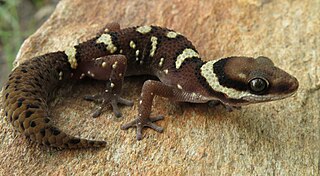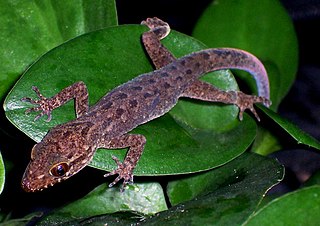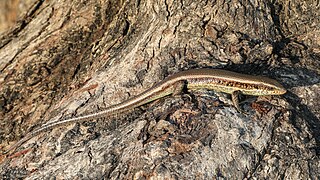
Gekko is a genus of Southeast Asian geckos, commonly known as true geckos or calling geckos, in the family Gekkonidae. Although species such as Gekko gecko are very widespread and common, some species in the same genus have a very small range and are considered rare or endangered.

Pachydactylus is a genus of insectivorous geckos, lizards in the family Gekkonidae. The genus is endemic to Africa, and member species are commonly known as thick-toed geckos. The genus also displays rich speciation, having 58 distinct species identified when compared to other closely related gecko genera like Rhoptropus, most of which have emerged since 35Ma. It has been suggested that the reason for this rich speciation not from adaptive radiation nor nonadaptive radiation, but that the genus represents a clade somewhere between the two drivers of speciation. P. bibronii geckos have been used by NASA as animal models for experimentation.

Cyrtodactylus is a diverse genus of Asian geckos, commonly known as bent-toed geckos, bow-fingered geckos, and forest geckos. The genus has 354 described species as of 2023, which makes it the largest of all gecko genera.

Homonota is a genus of South American geckos, commonly known as marked geckos.

Ptychozoon was a genus of arboreal geckos, endemic to Southeast Asia, known commonly as flying geckos, gliding geckos, or parachute geckos. They all are now placed in the genus Gekko in the family Gekkonidae. The biogeographic history of the genus Ptychozoon was deeply nested within that of the genus Gekko, the center of diversity of which is within Southeast Asia. Since dispersing into Southeast Asian rainforests, Pytochozoon, like other forest-dwelling vertebrates, adapted to facilitate gliding. All species in the genus Ptychozoon are characterized by cryptic coloration and elaborate webs surrounding the neck, limbs, trunk, and tail. These membranes help to conceal the gecko against trees. When the gecko leaps into the air, the flaps are used to generate lift and allow the gecko to control its fall. It can glide up to 200 feet. Also it does a swoop at the end of its glide to land softly. A similar adaptation is found in geckos of the genus Cosymbotus. There were thirteen described species in the genus Ptychozoon.

Gekko kuhli, commonly known as Kuhl's flying gecko, Kuhl's parachute gecko, or the gliding gecko, is a species of lizard in the family Gekkonidae. The species is found in Southeast Asia.

Eutropis is a genus of skinks belonging to the subfamily Mabuyinae. For long, this genus was included in the "wastebin taxon" Mabuya; it contains the Asian mabuyas. They often share their habitat with the related common skinks (Sphenomorphus), but they do not compete significantly as their ecological niches differ. This genus also contains the only member of the subfamily to occur in Australasia, the many-lined sun skink, whose wide range includes New Guinea.
Cyrtodactylus tautbatorum is a species of gecko, a lizard in the family Gekkonidae. The species is endemic to Palawan in the Philippines.

Lepidodactylus herrei, known commonly as the Negros scaly-toed gecko or the white-lined smooth-scaled gecko, is a species of gecko, a lizard in the family Gekkonidae. The species is endemic to the Philippines.
Brooks's wolf gecko is a species of lizard in the family Gekkonidae. The species is endemic to Sumatra.
Gekko browni, also known commonly as Brown's gecko, Brown's fringe gecko, and Brown's wolf gecko, is a species of lizard in the family Gekkonidae. The species is endemic to West Malaysia.

Luperosaurus corfieldi is a species of gecko, a lizard in the family Gekkonidae. The species is endemic to the Philippines.

Luperosaurus cumingii, also known commonly as Cuming's flapped-legged gecko and the Philippine wolf gecko, is a species of lizard in the family Gekkonidae. The species is endemic to southern Luzon in the Philippines.

Pak Djoko's flap-legged gecko, also known commonly as Iskandar's wolf gecko, is a species of gecko, a lizard in the family Gekkonidae. The species is endemic to Sulawesi.

Luperosaurus joloensis, also known commonly as the Jolo flapped-legged gecko and Taylor's wolf gecko, is a species of lizard in the family Gekkonidae. The species is endemic to Jolo in the Philippines.

Luperosaurus kubli is a species of gecko, a lizard in the family Gekkonidae. The species is endemic to Luzon in the Philippines.

Luperosaurus macgregori, known commonly as MacGregor's wolf gecko or McGregor's flapped-legged gecko, is a species of gecko, a lizard in the family Gekkonidae. The species is endemic to the Philippines.

Luperosaurus palawanensis, also known as Palawan wolf gecko or Palawan flapped-legged gecko, is a species of gecko. It is endemic to Palawan in the Philippines.
Luperosaurus yasumai is a species of gecko, a lizard in the family Gekkonidae. The species is endemic to Indonesian Borneo.

Jagor's sphenomorphus is a species of skink, a lizard in the family Scincidae. The species is endemic to the Philippines. There are two recognized subspecies.
















